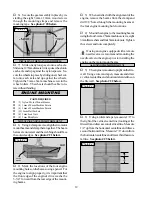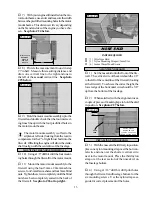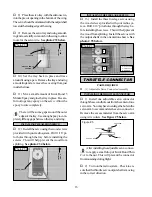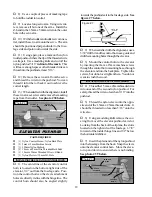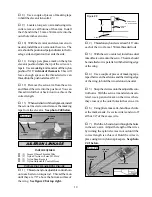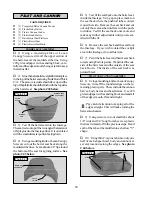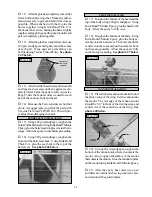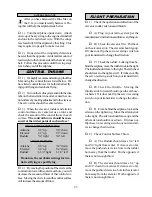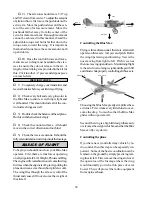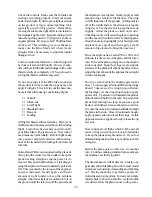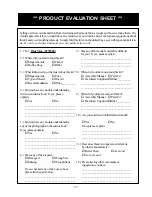
26
The descent should be gentle so let the nose drop
about 10 to 20 degrees. Keep the wing level
unless a turn is required. If you must turn, bank
usual to start the turn but only hold about half of
the normal amount of up elevator you usually hold
to maintain a turn. In doing so, you will not slow
the airplane too much. When you've reached your
desired altitude, level the wings and add throttle
as you add some up elevator to level the plane.
The final maneuver will be landing. For your first
landing, the goal should be to get the plane down
anywhere on the field without hitting anything.
Landings should always be made into the wind.
Usually, it is easiest to et up for a landing by mak-
ing a landing approach. The first part of the land-
ing approach is the descent. Descend going with
the (opposite of the direction you will be land-
ing). Once you've descended to an altitude of
30-50 feet, turn into the wind. At this point level
the wings, throttle back to idle and allow the nose
to drop to descend to the ground without getting
too slow. When the plane is 10 feet off the ground
(just above eye level), apply small amounts of up
elevator to slow the descent and to slow the plane.
Remember to keep the wings level. Now the
plane should descend but will seem like the nose
has not dropped much. If the plane doesn't de-
scend, allow the nose to drop a little. Just before
the plane touches down, apply some up elevator
to the level the plane with the ground. Because
the engine is at idle (or off completely) the plane
will still drop and touch down.
Things to avoid
1) Stalling. Stalling is when the air stops
flowing over the wing properly. For the Blue
Max, this only happens when the airplane is
flying too slow. A stall normally results in the
nose dropping uncontrollably. If a stall does
occur, allow the nose to drop, which will in-
crease the airspeed, then apply up elevator
to level the plane. Remember to not pull too
much up elevator or the stall may occur again.
2) Radical Turns. Keeping the wings level
or making standard turns are big steps in pre-
venting the plane from getting gout of control.
If the plane seems too fast or getting into too
steep a turn, try letting all the controls go to
neutral, then reduce the throttle and make
corrections to level the wings and then level
the plane.
3) Overcontrolling. Most new pilots try to
fly like they are playing a video game. Most
likely, you will never need full stick move-
ment for any correction. Typically, you will
need very little down elevator as well. Re-
member to move the stick in only small
amounts at a time. The radio control system
you are using is proportional meaning the
amount you move the stick is in direct pro-
portion to the amount the control surface
moves. Full deflection of the control surfaces
is typically reserved for correcting a major
mistake or trying an aerobatic maneuver.
Planning the first flight
After reading through the maneuvers, you need
to plan your first flight. For your first flight, pick a
day that is clear and not windy. Too much wind
will complicate your first flight. Take the time to
envision the flight path. The flight will, of course,
begin with take off and climb-out. Once a safe
altitude has been reached, make a turn down wind
and continue to climb. Level off at about 100
feet of altitude. Try to perform a basic figure 8
pattern. Learn to make small corrections to keep
your plane pointed in the direction you want it to
fly. After 3 or 4 minutes, begin your descent to
land. Try to turn into the wing to land. If you're
first landing gets the plane down in one piece and
is located somewhere on the flying field, that is
pretty good!
We hope this information will help you make those
first few flights successful.
Happy Landings!

